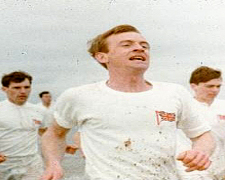I know, I know, you’re a bodybuilder. You don’t want to hear about doing cardio. But here’s the thing: if you want to get really cut, you’ve got to get really lean. Along with diet, cardio is the way to get to your ideal physique.
I’ve been in the “I hate cardio” camp before, and it was easy to justify because I was doing two 2-day splits in the weight room. What I hadn’t taken into consideration was that, even though I looked pretty hot, I was a little puffy still.
Even more than that, I realized that I had to maintain my heart health so I could stick around to see my kids grow up, and get to an age where it would be acceptable to talk about whippersnappers and the good old days.
As much as we all want to look amazing, we all know that that alone is useless if we don’t have good overall health. If you have the physique of a Greek god(dess) and a strong, lean heart muscle, you’re going to be the envy of the gym for decades to come!
What Is HIIT?
HIIT stands for high intensity interval training. Before you bow out of this article, let me entice you with this little gem: you can do your cardio work, start to finish, in 20 minutes. That includes warm up and cool down. I know, I know, unbelievable.
No more slaving on the bike, managing as much resistance as possible until you start hallucinating. No more mind-numbing hours walking on the treadmill.
If you’re cutting, you want to burn as much fat as possible. If you’re bulking, you want to minimize your fat gains. If you’re maintaining and want to surpass your previous aerobic and anaerobic thresholds, you need to shake up your workout. All of these are great reasons to do HIIT.
When you look at soccer forwards and basketball guards, they’re usually the leanest guys on the team. That’s because they spend most of their respective games in moderate motion, followed by periods of anaerobic work. That, in a nutshell, is what HIIT is.
Periods of moderate activity are followed by short bursts of intense activity. You’ll alternate those periods for mere minutes and, in so doing, burn up to nine times more fat than those who maintain a consistent elevated heart rate throughout a 20-60 minute workout.
Who Should NOT Do HIIT?
Those who are obese, or even particularly bulky lifters who are not accustomed to cardio might want to skip HIIT because of the sheer stress on the joints.
If you have heart problems, lung issues like asthma, or any other chronic diseases like diabetes, you may want to stay away, at least until you’ve got clearance from your medical professional and your disorder is well controlled.
Finally, if you’re lifting six days per week, you just don’t have time to do cardio. I don’t honestly believe that most people benefit from from lifting that much, but if you’re doing it, you likely know what you’re doing and exactly why.
How to Work HIIT into Your Routine
Last time we talked about “high intensity” training, it was resistance training, or HIRT. These two forms of exercise dovetail beautifully and accomplish your workouts in one quarter to one half the time you’re probably taking now.
If you’re looking to maintain, do HIIT two days per week and one longer steady cardio session. You do HIRT two days per week, and won’t need to do any full body resistance training (RT) like a traditional builder would do. Take the other two days as rest days.
If your priority is to keep your gains and drop fat, you’ll do one day of HIIT, two days of full body RT, one day of HIRT, and three days of rest.
Finally, if your goal is to gain muscle, you’ll want to do one day of HIIT or low and slow cardio, three days of full body RT, two days of HIRT, and one day off.
HIIT for Cardiovascular Endurance
You’re in maintenance mode, that short, blissful period of time when you’ve come off of some big gains (and hopefully a few new personal bests) and aren’t dieting down for a competition or beach vacation. It’s the best time to be a bodybuilder, when you’re off the crazy cycle!
Your best bet for a HIIT workout is either on the road or on the treadmill. Since the mercury is creeping up toward 100 degrees and it’s still June, I opt for indoor running. That, combined with the fact that you can’t trick the treadmill once you set it, are the best reasons to hightail it to the gym.
The easiest HIIT workout for you is alternating 30 seconds of moderate jogging with 30 seconds of all-out sprints. When I say sprints, I want your heart left on that machine. If not your heart, at least the gastric remains of your last meal, if you get my drift.
The first two weeks, do eight minutes, meaning that you’ll do eight jogs and eight sprints. The following two weeks, add two minutes, or ten jogs and ten sprints. Generally speaking, you’ll max out at 15 minutes of HIIT, though some people (who are certifiably nuts) like to go up to 20 minutes.
HIIT for Cutting
 You’re already in the worst part of a bodybuilders phases, and I’m sure you’re grumpy because you’re not eating any carbs. Believe you me, I have no desire to make you want to throw plates at my head.
You’re already in the worst part of a bodybuilders phases, and I’m sure you’re grumpy because you’re not eating any carbs. Believe you me, I have no desire to make you want to throw plates at my head.
The good news is that even though you’re in cutting mode, you don’t have to slave away on the machines for hours to shed fat. You can put in the same amount of time as the maintenance jerks and get some amazing fat-melting results.
Instead of jogging during your 30 second recovery periods, you’ll walk briskly. You’ll still have to leave everything you’ve got on the mat during your sprints, but at least you get the joy of walking instead of jogging as you gasp for breath.
You’ll do eight minutes in alternating 30 second intervals for the first two weeks, ten minutes the second two weeks, 12 minutes weeks five and six, and 14 minutes for the final two weeks. If you’re still cutting after eight weeks, well, I just feel sorry for you.
HIIT for Bulking
 Oh yeah, you’re living the high life. Eating carbs, lifting heavy, sleeping a lot, yours is one good life. It’s probably the reason that most serious lifters stay in the sport, getting to live like “normal people” when they’re in bulking mode. Well, if normal people eat 5,000 calories per day, that is.
Oh yeah, you’re living the high life. Eating carbs, lifting heavy, sleeping a lot, yours is one good life. It’s probably the reason that most serious lifters stay in the sport, getting to live like “normal people” when they’re in bulking mode. Well, if normal people eat 5,000 calories per day, that is.
Anyhow, back to your workout. You’re already cruising, but when your goal is to add muscle mass while keeping fat gains to a minimum, you’ve got to be serious about your cardio.
Since these workouts are shorter to prevent muscle wasting, you’ve got to give every ounce of guts you’ve got. Seriously, I know you want to spend as little time as possible cutting later, so be sure to put everything you’ve got into these short workouts.
You’re going to alternate a light jog and an all-out, gut wrenching, Chariots of Fire style sprint to the end. Since this workout is only five minutes worth of 30 second intervals for the first two weeks, you don’t have time to slack, cream puff.
Add two minutes every other week, but don’t exceed fifteen minutes no matter how long you’re bulking. It is best to stay between 9 and 11 minutes, but of course that depends on how big you’re looking to get in this phase.
Final Thoughts
If you’re not into running, you can alternate your walking/light jogs with jumping rope. Personally, I can barely manage not to trip over the rope, much less skip Rocky style, but if that’s your thing, it’s a fantastic workout.
Be sure to jump as fast as you can in your intervals. If you have the balance, coordination and desire, single leg lumping is fantastic for getting the heart rate up into the stratosphere.
Double-high knees will accomplish just about the same work without as much risk of bashing your head into the mirror and looking like a total idiot, but to each his own.
You can also manage to do your high intervals on an elliptical, a recumbent bike, or an erg/rowing machine. So long as you remember to go light in the breaks and “go to the mattresses” in the sprints, you’ll have yourself a fantastic fat-blasting workout!